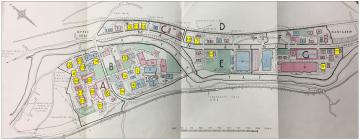Content can be downloaded for non-commercial purposes, such as for personal use or in educational resources.
For commercial purposes please contact the copyright holder directly.
Read more about the The Creative Archive Licence.
Description
The following account looks at the events that took place on the canal over it’s lifetime. It wasn’t alway’s plain sailing on the canal, things did go wrong, we have tried to capture these events, but as well, on a more happier note, we will also look at people memories of the canal as well.
Mary Anne Aubery memories of the canal:
(with thanks to Rhodri Evans for sharing his grannies memories of the canal.)
My mother was brought up in Tai'r Felin, the old mill houses next to 'Y Ffatri’, the old flannel mill at the Lamb-and-Flag. My mother, like all the people who lived there, knew the 'batwyr', the boatmen on the canal.
One of my earliest recollections was travelling on a barge from Mill Row to visit my aunt at Deri Fach (this aunt, incidentally, was known affectionately in the family as 'Y Gwdihw', meaning 'the owl', from her habit of staying so late whenever she visited us in the village that one of the young men always had to go back with her to Deri Fach, sometimes in the pitch dark). To me it was a wonderful experience, travelling on the barge. I remember the gates opening, and the water rushing like a waterfall. My small brother who was with us, was terrified. "Oh! Mam! Mam! Mae'r bad yn crafi'r ochr". I remember him crying. (Oh! Mam! the boat is scratching the sides). We travelled on and disembarked finally at Llina Lock. The names of the two barges bringing gunpowder from the Powder Works were Alfred and Henry.
People travelled quite a lot on the barges. The children of the Lamb and Flag used to come up to school on them. Someone fell into the canal one night. A passer-by heard the struggling and shouted:-
"Who's there?".
Back came the answer, quick as a flash.
"Captain Webb."
(editor’s note – Captain Webb was the first person to swim the English Channel, in 1875. He was a great celebrity at the time)
I do remember the factory working - water from an aqueduct from the canal forced the great wheel around. I was thrilled to see the water spouting from it.
Accidents on the Canal:
In the book 125 years of Eduction, Oddfellows school, Glynneath, there are two mentions of accidents to the children of the school. The first on the 5th August 1870 when it was reported that a boy had fallen into the canal and nearly drowned. (p15) The second was more serious, as a little girl from the school fell into the canal and was drowned, the book reported this event in the school log of 14th September 1871. (p18)
At Resolven a tram from the local mine travelling down to the canal failed to “spike” and the driver, the horse and the tram ended up in the canal.
I guess there were many other incidents or accidents along the canal, but these are the only examples I could find to date.
Unusual loads carried on the canal:
In 1812 two barges carried fifteen 18 pound cannons produced at the Abernant / LLwyncoed Foundries and destined for the Napoleonic War. (Neath Canal Trust)
At Aberdulias there was no bridge to cross the river from one side of the valley to the other side, the only way was by canal over the viaduct. People wishing to bury their loved ones at St Catwg , Cadoxton had to carry the coffins on a barge across the river by the canal at Tonna, the charge for this was 1 pence / coffin.
Another unusual load was the conveyance of gunpowder on the canal. The gunpowder would be conveyed from the Gunpowder Works at Pontneathvaughan in barrels by horse to Abernant canal head where they had their own stores. It was then transported by the Neath Canal to Red Jacket Wharf, Briton Ferry where it was subsequently loaded to sailing ships and delivered to their customers abroad.
The company had their own Barges, called Alfred, Henry and Robert. The Bargees names were Elias Leach and William and Thomas Harriet, James Jones, Henry James and Thomas Williams. (Neath Canal Trust, Newsletter )
The Barges had to travel by night, were covered, and were lit with two Red warning lanterns at either end of the barge. There is some discussion on whether the horse pulling the Barge had copper shoes, but the more likely guess is that it used a 50 foot towing rope so the horse was kept well away from the Barge if it was to throw up a spark from hitting a rock.
Once it had delivered it’s gunpowder load it carried other material on the return journey, such as Salt Peter, and Brimstone which were used for the manufacture of the gunpowder.
There were many Church Outing trips for the adults and children on the canal to, typically they would travel down to Briton Ferry or the beach at Jersey Marine where they would spend the day, and they also ran Barges to Neath Fair.
It also worked the other way, people from Swansea and Neath would travel up to the Head of the canal where they would get off and either walk or hire a pony and trap to take them to Pontneddvechan for a day out visiting the waterfalls.
Cnel Bach:
The canal branch Cnel Bach (Little canal) is of interest to the village as it was to play a big part in the development of industry in the village. The canal branch was built by the colliery owner Edward Protheroe, and the branch joined the canal between the Maes Gwyn (White Field) lock and the Ynys Y Allor ( Meadow of the Alter) lock. The short canal branch was then connected by tram to Mr Protheroes colliery at Fforch Coch, the “Plateway” tram road costing 15 Guineas to build.
The tram road crossed the river Neath by means of a wooden bridge and connected with the end of Cnel Bach where the coal was tipped from the trams and loaded onto the canal barges. In this area were a number of works buildings, a Wharf House, stables, a smithy to facilitate the work carried out there. There was also an old lime Kiln in this area, the lime being used for local building, agriculture and sanitary requirements in the local area.
This tram road bridge across the river was used by the schoolchildren of Rheola and Pentreclwyda to get to school in Cwmgwrach. The bridge remained open as a footpath after the tram road was partially built over by the Vale of Neath Railway, but was eventually condemned as unsafe and closed in the 1880’s. The children were then transferred to the school in Resolven.
It was from this short length of canal that 10 barges carrying Cwmgwrach coal from the Forch Coch collieries of Edward Protheroe left to join the procession for the opening of the Tennant Canal on 13th May 1824.
Resources and References:
The History of the Vale of Neath, D. Rhys Philips (facsimile edition), chapter XIV ~ Roads, Canals, Railways Bridges, Inns
Neath and District, A Symposium, Edited by Elis Jenkins, pages 239 – 24.
The Canals of the Welsh Valleys, and their tramroads ~ D.D. & J.M Gladden 1991.











Do you have information to add to this item? Please leave a comment
Comments (0)
You must be logged in to leave a comment